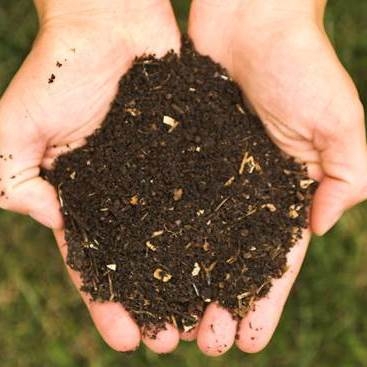Compost
Compost is the product of controlled decomposition of biodegradable materials, such as yard trimmings and food scraps.
Why use compost?
- Improves the fertility and health of your soil.
- Increases crop yields.
- Recycles valuable organic resources and keeps them out of landfills.
- Saves water by helping the soil hold moisture.
How to use compost?
- Incorporate 2-4 inches of compost to annual edible beds before planting.
- Topdress fruit trees and perennial food crops every 6 months.
Which compost is best?
- Backyard compost is best, learn how to make your own compost.
- Buy compost certified by the Organic Materials Review Institute (OMRI) or registered as CDFA organic compost. Check our Marketplace to find vendors that sell compost.
Mulch
Mulch is any material evenly spread over the surface of the soil. Plant-based mulches help build healthy soil.
Why mulch?
- Retain soil moisture and moderate soil temperature.
- Suppress weeds.
- Prevent erosion and soil compaction.
- Improve soil life and health.
- Protect soil when not planting right away.
- Recycles valuable organic resources and keeps them out of landfills.
How to mulch?
- Put mulch under fruit trees. (Start mulch 6 to 12 inches away from the base of the tree to prevent rot or disease.)
- Coarse, woody mulch is best for weed control along paths and between beds.
- Straw decomposes more quickly than woody mulch and can be used for weed control around annual crops.
- Finer mulch is a better soil conditioner as it will break down faster.
- Topdressing (simply applying on top of the soil rather than mixing into the soil) with compost will slowly release nutrients and act as a mulch.
Which mulch is best?
- Recycled pallet and lumber mulch is often available dyed and is best suited for paths or other high traffic areas.
- Arbor mulch can often be delivered in bulk from tree trimming companies and can be used for your initial sheet mulching, paths, weed suppression and around trees.
- Mixed green waste mulch includes a combination of tree trimmings, chipped brushy materials and other plant trimmings. It provides a broad range of nutrients essential to building healthy soil and is useful throughout the garden.
- Compost is a soil amendment but is also suitable as a mulch when top dressing annual edible beds.
- Leaves can be used as a mulch, especially when you let them lie where they fall, under tree and shrub canopies.
- Straw is an effective mulch for weed control and water retention in edible gardens.
- Check our Marketplace to find vendors that sell mulch.
Cover Cropping
Cover cropping involves planting a green manure that will be worked in to feed and care for the soil. Most gardeners use a blend of legumes, such as clover and bell beans, and grasses, such as oats and rye.
Why cover crop?
- Add nitrogen and organic matter to the soil.
- Prevent soil erosion and break up compaction.
How to cover crop?
- Clear out old crops and prepare a bed for planting.
- Broadcast cover crop seed in time for the fall rains in mid-to-late October.
- Cut cover crop down in the spring when about a quarter of the legume’s flower buds open.
- Chop and work the cover crop back into the soil to add organic matter.
Which cover crop is best?
- Legumes, such as bell beans, clover and vetch, fix nitrogen from the atmosphere and add it to the soil.
- Grasses, like rye and oats, have extensive root systems that can help aerate soil and reduce erosion. They also produce large amounts of vegetation that in turn adds organic matter to the soil.
- Buckwheat is quick growing and helps suppress weeds. It is frost sensitive and can be useful for growing after an early spring crop.
Visit our Marketplace for a list of local nurseries stocking compost, mulch and cover crop seeds.


